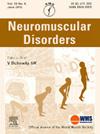An HTLV-1 carrier with sporadic late-onset nemaline myopathy accompanied by skin lesions indicating indolent adult T-cell leukemia/lymphoma and Sjögren’s syndrome: a case report and literature review
IF 2.7
4区 医学
Q2 CLINICAL NEUROLOGY
引用次数: 0
Abstract
Sporadic late-onset nemaline myopathy (SLONM) is a rare acquired myopathy. Herein, we report a rare case of co-occurring SLONM, indolent adult T-cell leukemia/lymphoma (ATL), and Sjögren’s syndrome (SS) in a 60-year-old woman who was a human T-cell leukemia virus type 1 (HTLV-1) carrier. She presented with sub-acute proximal muscle weakness and chest erythema. Muscle biopsy revealed perivascular inflammation and accumulation of nemaline bodies in the atrophic fibers. Skin biopsy indicated indolent ATL. Analysis of specific antibodies and salivary gland biopsy led to a SS diagnosis. CD4-positive T cells expressing FoxP3 and CCR4, which constitute an HTLV-1-infected cell signature, were observed in all three tissues. Her muscular and cutaneous symptoms responded well to steroids. This case suggests a potential link between HTLV-1 latent infection and reactivation and SLONM development and progression. We review the clinicopathological features of SLONM across various etiologies, providing valuable insights into this rare condition.
HTLV-1携带者,散发迟发性线状肌病伴皮肤病变,提示成人惰性t细胞白血病/淋巴瘤和Sjögren综合征:1例报告和文献复习
散发性迟发性线状肌病(SLONM)是一种罕见的获得性肌病。在此,我们报告了一例罕见的SLONM,惰性成人t细胞白血病/淋巴瘤(ATL)和Sjögren综合征(SS)同时发生在一位60岁的女性,她是人类t细胞白血病病毒1型(HTLV-1)携带者。她表现为亚急性近端肌无力和胸部红斑。肌肉活检显示血管周围炎症和萎缩纤维中线状体的积累。皮肤活检显示无痛性ATL。特异性抗体分析和唾液腺活检导致SS诊断。在所有三种组织中均观察到表达FoxP3和CCR4的cd4阳性T细胞,它们构成htlv -1感染细胞的特征。她的肌肉和皮肤症状对类固醇反应良好。该病例提示HTLV-1潜伏感染和再激活与SLONM的发展和进展之间存在潜在联系。我们回顾了各种病因的SLONM的临床病理特征,为这种罕见的疾病提供了有价值的见解。
本文章由计算机程序翻译,如有差异,请以英文原文为准。
求助全文
约1分钟内获得全文
求助全文
来源期刊

Neuromuscular Disorders
医学-临床神经学
CiteScore
4.60
自引率
3.60%
发文量
543
审稿时长
53 days
期刊介绍:
This international, multidisciplinary journal covers all aspects of neuromuscular disorders in childhood and adult life (including the muscular dystrophies, spinal muscular atrophies, hereditary neuropathies, congenital myopathies, myasthenias, myotonic syndromes, metabolic myopathies and inflammatory myopathies).
The Editors welcome original articles from all areas of the field:
• Clinical aspects, such as new clinical entities, case studies of interest, treatment, management and rehabilitation (including biomechanics, orthotic design and surgery).
• Basic scientific studies of relevance to the clinical syndromes, including advances in the fields of molecular biology and genetics.
• Studies of animal models relevant to the human diseases.
The journal is aimed at a wide range of clinicians, pathologists, associated paramedical professionals and clinical and basic scientists with an interest in the study of neuromuscular disorders.
 求助内容:
求助内容: 应助结果提醒方式:
应助结果提醒方式:


